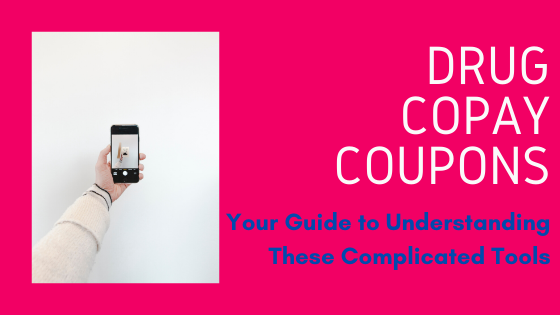How to save money on Super Expensive Prescription Drugs!

These special prescription co-pay cards can save you from $500/mo to $5,000/mo in many situations for extremely expensive pharmacy drugs!
There is a secret that drug companies don’t want you to know about. Well, they sort of want you to, but not really. As we all know anything medically related is complex like an onion and many layers that are not fully transparent at first glance. We are going to dig into this for you and give you some tips and tricks on how to save money on the ultra-expensive specialty drugs you or a family member may take. We are here to save you money and wanted to break it all down. Today I want you show you how to get a $1,000 cash price prescription drug for often $10 per month. The ironic thing is that the manufacturer is the one administrating the Prescription Drug Copay cards. Yes, they sell it for the full price and super discounted price at the same time. Make sure to scroll all the way to the bottom as we have a list of some commonly used Copay cards with links directly for you to enroll in them.
First, any prescription drug advertised on television is clearly an expensive brand name drug, or they would not take the time or millions of dollars to make their weirdly named drug known to the average person. Second, they make most of their money from employer group plans which conveniently cover most of these drugs at a very low co-pay cost to you. These very expensive drugs are costing your employer a small fortune and you don’t even know it. You should care since they hypothetically could give you a larger pay raise if they saved money on health insurance.
Many people that are self-employed or retired before they turn 65 and go onto Medicare need to purchase their own individual health insurance plan on a state health exchange. In Washington State we have the HealthPlanFinder. As many of you reading this now realize that individual plans make you pay a higher amount for prescription drugs than employer plans. In general, if you have an extremely expensive Rx, the best plan is a Cascade Gold plan (yet not always). Feel free to ask us why when you call us.
The manufacturers of prescription drugs have a patent which means they can only offer the drug at a brand name price until the patent ends, then cheaper generics can be available. For those that get a $1,000 expensive TV branded drug and pay $50 on their employer plan don’t care. However, if you have an individual plan and must pay $1,000 before your plan kicks in for a Tier 3 or Tier 4 drug, you care a lot! The manufacturers know that those with the most pain complain the loudest. For example, if 95% of people on an expensive TV advertised drug like Humira are on a group plan and it only costs them $50 per refill that is doable for most budgets. However, if you walk into the pharmacy with an individual plan that covers this drug after your deductible, it might cost you $5,000. You are not going to shell out that much money on the spot. So, the manufacturer decides to implement a Copay Card which after you enroll can get you the same prescription for as little as $5 per month. They do this to keep those that are on individual plans from complaining too much. Afterall, if you have only 5% of people on these Copay Cards you can still charge the employer plans $5,000 and come out ahead.
VERY IMPORANT WASHINGTON STATE CARRIER INFORMATION:
Be careful, Molina and Bridgespan do not recognize copay cards and therefore you are on your own to meet your deductible and max out-of-pocket.
- Premera, LifeWise, Regence (only specific list), Kaiser…not Molina, Maybe AM Better.
Remember, as we learned in a previous blog post, prescription discount cards are not insurance. But while independent discount cards are used instead of insurance, manufacturer copay cards can be used with commercial or private insurance plans.
Here’s how it generally works: patients sign up for a card through the manufacturer’s website. Once enrolled in the copay program, the patient will receive a card from the manufacturer. When the patient shows the card to the pharmacist, the pharmacy processes the prescription using the patient’s insurance information as the primary payer and the copay card information as the secondary payer. The patient then pays a small portion of their copay or nothing at all, and the drug manufacturer will pick up the rest of the copay.
The patient’s pharmacy benefit manager (PBM) pays for the drug itself. For that reason, PBMs prefer patients to choose less-expensive drugs from the get-go. To further discourage the use of copay cards, PBMs have also implemented copay accumulator programs. These ensure that only your reduced copayment will go towards your deductible, not the entire price of the drug. When your copay card expires, you could be surprised with a big pharmacy bill.
Medicare Part D or Medicaid patients cannot use manufacturer copay cards due to anti-kickback laws. Also, it is argued that about 60% of the time manufacturer cards are for brand-name drugs that have lower-cost, generic alternatives. While copay cards may reduce a member’s personal out-of-pocket costs, the government would get stuck with the bill for an expensive brand-name drug. Many believe that over time, covering those brand-name drugs would increase the cost of Medicare and Medicaid for taxpayers.
Gary Franke, Tamara Chandler, Brianna Crawford & Melissa Tibbs
Heffernan Insurance Brokers
Individual Health & Medicare Specialists
1100 Bellevue Way NE, Ste 8A-545
Bellevue, WA 98004
425-802-2783 (call or text office line)
[email protected]
www.wahealthplan.org
